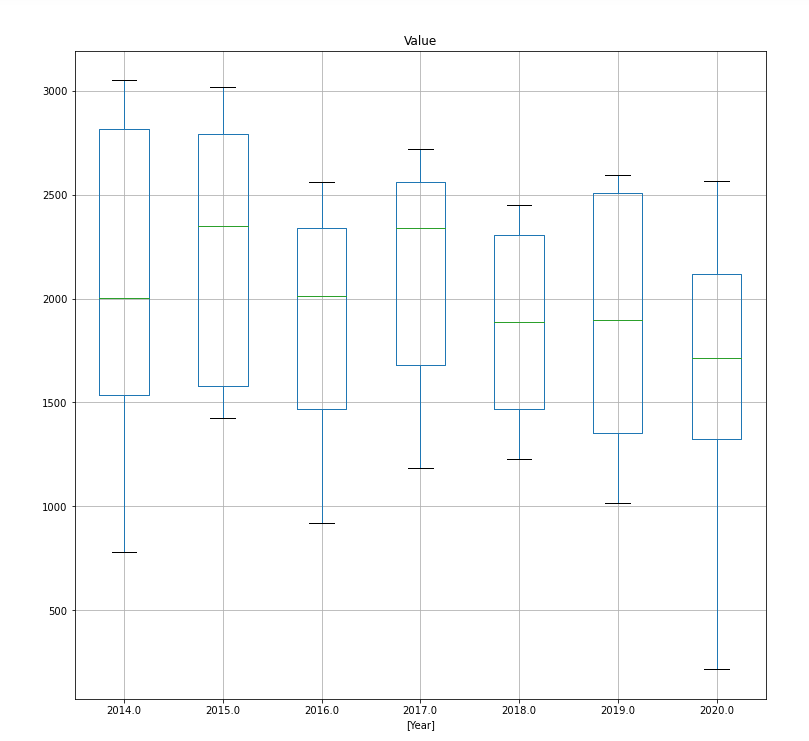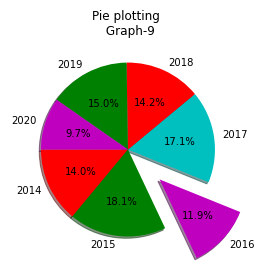Data Engineer Course Final Project - MBTA API
This Project was created as the Final Project in the Big Data Engineer course at Naya College By Nitay Yacobovitch, Shoham Gilady and Dor Izmaylov. We used M...
This post shows an analysis that I did of the solar system at my home - and its performaמce. It contains the total yield from the last 6 years - on top of that I made some data cleansing, showed few insights and provided graphs.
# This Python 3 environment comes with many helpful analytics libraries installed
# It is defined by the kaggle/python Docker image: https://github.com/kaggle/docker-python
# For example, here's several helpful packages to load
import numpy as np # linear algebra
import pandas as pd # data processing, CSV file I/O (e.g. pd.read_csv)
import seaborn as sns
import matplotlib.pyplot as plt
# Input data files are available in the read-only "../input/" directory
# For example, running this (by clicking run or pressing Shift+Enter) will list all files under the input directory
import os
for dirname, _, filenames in os.walk('/kaggle/input'):
for filename in filenames:
print(os.path.join(dirname, filename))
# You can write up to 5GB to the current directory (/kaggle/working/) that gets preserved as output when you create a version using "Save & Run All"
# You can also write temporary files to /kaggle/temp/, but they won't be saved outside of the current session
/kaggle/input/annualcomparisonsolarsystem/Annual_Comparison_2020_07_04.csv
solar = pd.read_csv("/kaggle/input/annualcomparisonsolarsystem/Annual_Comparison_2020_07_04.csv") # the solar dataset is now a Pandas
solar.head()
solar = solar.dropna(subset=['Total yield [kWh]'])
print(solar.to_string())
Total yield [kWh] January February March April May June July August September October November December Total
0 2014.0 NaN NaN NaN NaN 780.67 2967.07 3050.46 2817.26 2329.23 1858.61 1537.28 1542.12 16882.69
1 2015.0 1427.24 1580.28 2350.50 2495.05 2880.93 2790.83 3017.52 2742.42 2235.77 1824.12 1479.86 1541.99 26366.50
2 2016.0 1312.06 NaN NaN NaN NaN NaN 922.20 2553.03 2339.24 2014.08 1571.30 1337.75 12049.67
3 2017.0 1484.67 1679.77 2016.53 2469.81 2707.03 2562.49 2514.67 2719.89 2340.79 1921.68 1437.16 1183.86 25038.34
4 2018.0 1227.53 1537.83 2304.27 2434.25 2264.23 2450.22 1781.75 2051.28 1888.90 1470.56 NaN NaN 19410.81
5 2019.0 1383.32 1499.07 1894.44 2311.29 2593.29 2460.69 2532.43 2505.71 1353.53 1193.87 1224.51 1017.01 21969.15
6 2020.0 921.59 1043.50 1445.02 1730.01 2118.69 2121.16 215.72 NaN NaN NaN NaN NaN 9595.68
cols = ['January','February','March', 'April', 'May', 'June','July', 'August', 'September', 'October', 'November', 'December' ]
solar[cols] = solar[cols].fillna(solar[cols].mean()) #Calculates nan values for the mean of the same column (the same month allover the years)
df = solar.melt(id_vars=["Total yield [kWh]"],
var_name="Month",
value_name="Value")
df = df.rename(columns={'Total yield [kWh]': 'Year', 'Value': 'Value'})
df = df.dropna(subset=['Year'])
print(df.to_string())
Year Month Value
0 2014.0 January 1292.735000
1 2015.0 January 1427.240000
2 2016.0 January 1312.060000
3 2017.0 January 1484.670000
4 2018.0 January 1227.530000
5 2019.0 January 1383.320000
6 2020.0 January 921.590000
7 2014.0 February 1468.090000
8 2015.0 February 1580.280000
9 2016.0 February 1468.090000
10 2017.0 February 1679.770000
11 2018.0 February 1537.830000
12 2019.0 February 1499.070000
13 2020.0 February 1043.500000
14 2014.0 March 2002.152000
15 2015.0 March 2350.500000
16 2016.0 March 2002.152000
17 2017.0 March 2016.530000
18 2018.0 March 2304.270000
19 2019.0 March 1894.440000
20 2020.0 March 1445.020000
21 2014.0 April 2288.082000
22 2015.0 April 2495.050000
23 2016.0 April 2288.082000
24 2017.0 April 2469.810000
25 2018.0 April 2434.250000
26 2019.0 April 2311.290000
27 2020.0 April 1730.010000
28 2014.0 May 780.670000
29 2015.0 May 2880.930000
30 2016.0 May 2224.140000
31 2017.0 May 2707.030000
32 2018.0 May 2264.230000
33 2019.0 May 2593.290000
34 2020.0 May 2118.690000
35 2014.0 June 2967.070000
36 2015.0 June 2790.830000
37 2016.0 June 2558.743333
38 2017.0 June 2562.490000
39 2018.0 June 2450.220000
40 2019.0 June 2460.690000
41 2020.0 June 2121.160000
42 2014.0 July 3050.460000
43 2015.0 July 3017.520000
44 2016.0 July 922.200000
45 2017.0 July 2514.670000
46 2018.0 July 1781.750000
47 2019.0 July 2532.430000
48 2020.0 July 215.720000
49 2014.0 August 2817.260000
50 2015.0 August 2742.420000
51 2016.0 August 2553.030000
52 2017.0 August 2719.890000
53 2018.0 August 2051.280000
54 2019.0 August 2505.710000
55 2020.0 August 2564.931667
56 2014.0 September 2329.230000
57 2015.0 September 2235.770000
58 2016.0 September 2339.240000
59 2017.0 September 2340.790000
60 2018.0 September 1888.900000
61 2019.0 September 1353.530000
62 2020.0 September 2081.243333
63 2014.0 October 1858.610000
64 2015.0 October 1824.120000
65 2016.0 October 2014.080000
66 2017.0 October 1921.680000
67 2018.0 October 1470.560000
68 2019.0 October 1193.870000
69 2020.0 October 1713.820000
70 2014.0 November 1537.280000
71 2015.0 November 1479.860000
72 2016.0 November 1571.300000
73 2017.0 November 1437.160000
74 2018.0 November 1450.022000
75 2019.0 November 1224.510000
76 2020.0 November 1450.022000
77 2014.0 December 1542.120000
78 2015.0 December 1541.990000
79 2016.0 December 1337.750000
80 2017.0 December 1183.860000
81 2018.0 December 1324.546000
82 2019.0 December 1017.010000
83 2020.0 December 1324.546000
84 2014.0 Total 16882.690000
85 2015.0 Total 26366.500000
86 2016.0 Total 12049.670000
87 2017.0 Total 25038.340000
88 2018.0 Total 19410.810000
89 2019.0 Total 21969.150000
90 2020.0 Total 9595.680000
boxplot = df.boxplot(by='Year',figsize=(12,12),showfliers=False)

print(df.groupby(['Year']).mean())
cols = ['r','g','m','c']
slices =[3,5,7,5]
activities=["2014","2015","2016","2017","2018","2019","2020"]
# explode()- Helps to extract the particular piece out.
# autopct='%1.1f%%' helps to add a percentage to the pie chart
plt.pie(df.groupby(['Year']).mean(), labels=activities, colors = cols,shadow =True,
startangle =180,explode =(0,0,0.5,0,0,0,0),autopct='%1.1f%%')
plt.title('Pie plotting \n Graph-9')
plt.show()
Value
Year
2014.0 3139.726846
2015.0 4056.385385
2016.0 2664.656718
2017.0 3852.053077
2018.0 3199.707538
2019.0 3379.870000
2020.0 2178.917923
/opt/conda/lib/python3.7/site-packages/ipykernel_launcher.py:9: MatplotlibDeprecationWarning: Non-1D inputs to pie() are currently squeeze()d, but this behavior is deprecated since 3.1 and will be removed in 3.3; pass a 1D array instead.
if __name__ == '__main__':

This Project was created as the Final Project in the Big Data Engineer course at Naya College By Nitay Yacobovitch, Shoham Gilady and Dor Izmaylov. We used M...
This post shows an analysis that I did of the solar system at my home - and its performaמce. It contains the total yield from the last 6 years - on top of t...
Recommendation on a great video, step by step instruction on creating interactive dashboard from scratch using the built in Excel tools.
This post shows an analysis that I’ve made of Mcdonalds Menu - The data i used holds information on all of the dishes from their menu, on top of that i made ...